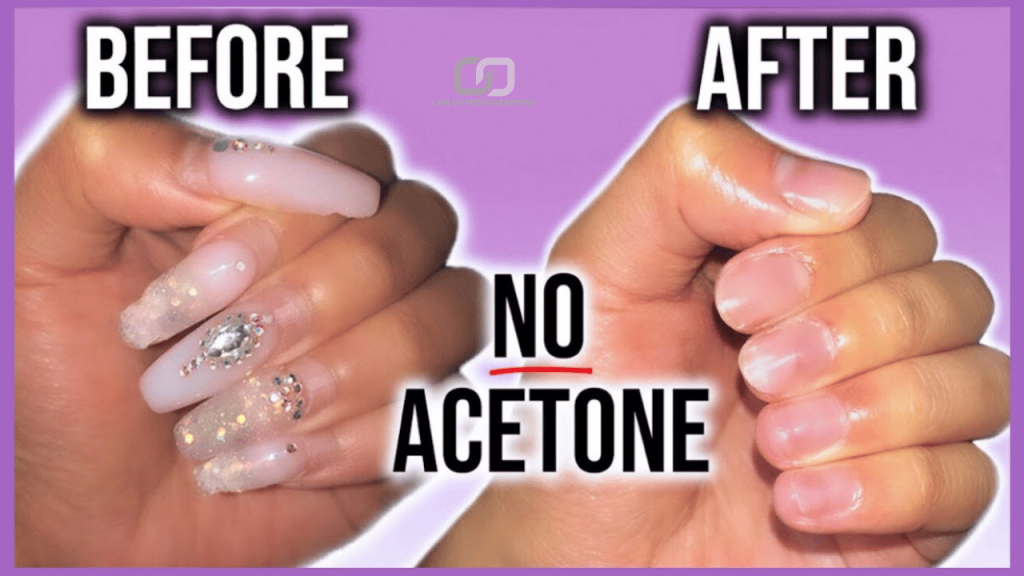Gel polish lasts longer than regular nail polish. It gives a smooth and glossy finish. But removing it can be tricky. Many people use acetone to take it off. Acetone works fast, but it can dry out nails and skin. There are other ways to remove gel polish without acetone. These include soaking nails in warm water, using oil, or gently buffing the polish off. These methods take more time but are safer for nails.
Acetone can make nails weak and brittle. It can also irritate the skin around the nails. Choosing an acetone-free method keeps nails healthier. Oils, lemon juice, and warm water help loosen the polish without causing harm. Buffing is another option, but it should be done carefully to avoid thinning the nails.
Table of Contents
Why Avoid Acetone for Gel Polish Removal
Acetone is a harsh chemical that removes gel polish quickly. But it also strips away natural oils from nails and skin. This makes nails dry, weak, and prone to breakage. Frequent use of acetone can cause nails to peel, split, or become brittle. The skin around the nails may also get irritated, leading to redness and discomfort. Some people even experience a burning sensation or white spots on their nails after using acetone.
Over time, acetone weakens the nail structure. It removes moisture, making nails rough and dull. If used too often, it can cause long-term damage, making nails thin and fragile. People with sensitive skin may find acetone too harsh, as it can cause itching or inflammation.
Choosing an acetone-free removal method helps protect nail health. Soaking nails in warm water, using oil, or gently buffing the polish off are safer options. These methods take longer but keep nails stronger and healthier.
Avoiding acetone prevents long-term nail damage. Healthy nails look better and last longer. Using gentle removal techniques keeps them smooth, moisturized, and strong. It’s a better choice for those who want to maintain healthy nails.
Preparation Before Removing Gel Polish
Gather the Necessary Tools
Before removing gel polish, make sure you have all the right tools. You will need a nail file, buffer, cuticle stick, a bowl of warm water, oil (such as coconut or olive oil), and a soft towel. Having these items ready makes the process easier and prevents unnecessary strain on your nails. Using the right tools also helps avoid damage and ensures a smooth removal process.
Trim and File Your Nails
Shorter nails are easier to manage and less likely to break during the removal process. Use a nail clipper to trim them to a comfortable length. Next, use a nail file to smooth the edges and remove any rough spots. If the gel polish is thick or has a glossy topcoat, gently file the surface to break the seal. This step allows the removal process to work more effectively, making it easier to take off the polish without excessive force.
Soften the Gel Polish
Before removing gel polish, it’s important to soften it to avoid damaging your nails. Soak your nails in a bowl of warm water for 10-15 minutes to loosen the polish. Adding a few drops of oil or lemon juice can make the process even gentler. The warm water helps weaken the polish, making it easier to remove with minimal effort. This step also keeps your nails hydrated and reduces the need for excessive buffing or scraping.
Alternative Methods to Remove Gel Polish
1. Soaking in Warm Water and Oil
A gentle way to remove gel polish is by soaking your nails in warm water mixed with a few drops of oil. Coconut oil, olive oil, or baby oil work well for this method. Soak your nails for 15-20 minutes to soften the polish. Once it starts to lift, use a cuticle stick to gently push off the remaining polish. This method keeps nails hydrated and prevents brittleness.
2. Using Lemon Juice and Vinegar
Lemon juice and vinegar have natural acidity that helps break down gel polish. Mix equal parts of lemon juice and vinegar in a bowl and soak your nails for about 10-15 minutes. The acids work to loosen the polish, making it easier to peel or gently scrape off. After removal, wash your hands and apply moisturizer to keep nails healthy.
3. Buffing the Gel Polish Off
Buffing is another acetone-free option, but it should be done carefully to avoid thinning the nails. Use a nail buffer to gently remove the top layer of the gel polish. Keep buffing in light strokes until the polish is gone. Apply cuticle oil afterward to restore moisture and prevent dryness. This method works best for those who want a slow, controlled removal process. If acetone-free methods intrigue you, consider reading how to remove gel nail polish from home for simple alternatives.
4. Peeling with a Cuticle Stick
If the gel polish has already started to lift, you can use a cuticle stick to peel it off gently. Start at the edges and slowly push the polish away from the nail. Avoid forceful peeling, as it can damage the nail surface. Soaking your nails in warm water before peeling helps make the process easier and less harmful.
5. Using Hydrogen Peroxide and Baking Soda
A paste made from hydrogen peroxide and baking soda can also help remove gel polish. Mix equal parts of both ingredients to form a thick paste. Apply it to the nails and let it sit for a few minutes. Gently scrub the nails with a soft brush to lift the polish. Rinse thoroughly and apply a moisturizer to prevent dryness.
How to Keep Your Nails Healthy After Removal
After removing gel polish, nails often become dry and weak. Moisturizing is the first step to keeping them healthy. Apply nourishing oils like coconut oil, olive oil, or vitamin E oil to your nails and cuticles. Massage the oil in to restore moisture and prevent brittleness. This simple step helps keep nails flexible and reduces the risk of cracks or peeling.
Trimming and filing nails properly is also important. Weak nails are prone to breakage, so keep them at a manageable length. Use a gentle nail file to smooth rough edges. Avoid metal files, as they can be too harsh. A fine-grit or glass file is a better option, as it prevents further damage and keeps nails strong.
Giving your nails a break after gel polish removal helps them recover. Avoid applying new polish for at least a week. Instead, focus on nail care by keeping them clean, moisturized, and protected. If nails feel weak, use a strengthening treatment with keratin or biotin. This helps repair damage and adds a protective layer.
Conclusion
Removing gel polish without acetone is possible with simple and safe methods. Soaking nails in warm water, using oil, or applying lemon juice can help loosen the polish. Buffing gently or peeling carefully can also work, but it’s important to avoid damaging the nails. These methods keep nails healthier and prevent dryness.
After removal, proper nail care is essential. Moisturizing, trimming, and giving nails a break help them stay strong. Using a nail-strengthening treatment and eating a balanced diet also improve nail health. With the right care, nails can recover quickly and remain smooth and healthy.


